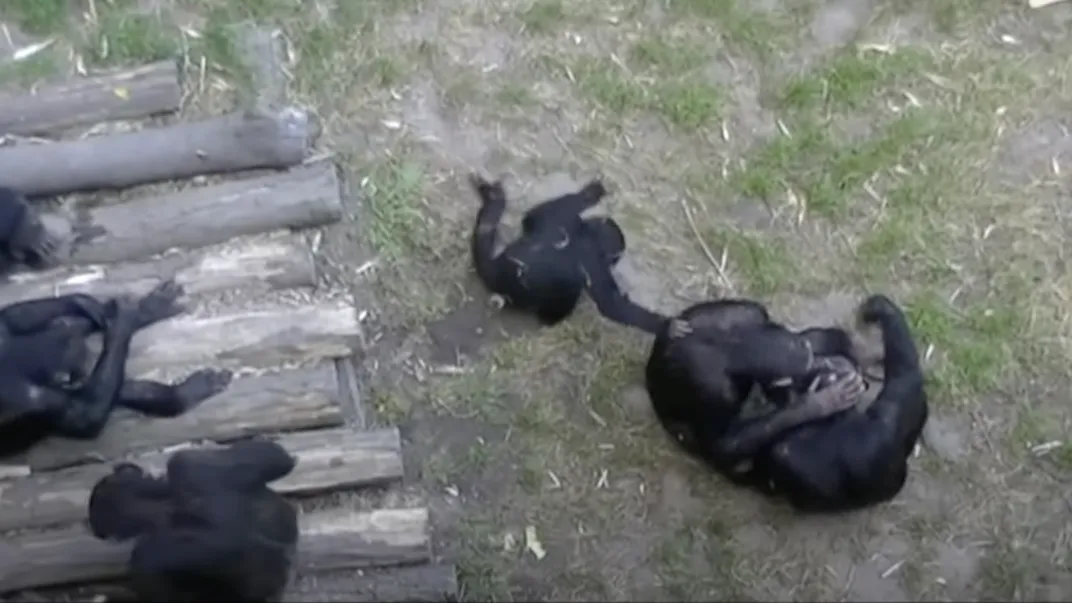Great Apes Love to Tease, Poke and Pester, Suggesting the Urge to Annoy Is Millions of Years Old
The desire to get a rise out of others is a 13-million-year-old trait humans and great apes share with a common ancestor, new research suggests
:focal(1024x770:1025x771)/https://tf-cmsv2-smithsonianmag-media.s3.amazonaws.com/filer_public/70/84/70848f33-6314-4098-987b-61f1d029ed95/3442198643_8a4827ec5e_o.jpg)
Teasing, poking and pestering—creatively perfected by human siblings across the globe—may be a far older pastime than we may have imagined, according to new research.
Scientists studying four primate species have discovered that young apes badger with the best of us, suggesting humans share the art of causing annoyance with some of our closest relatives. In a new paper published Wednesday in Proceedings of the Royal Society B, researchers argue this shared behavior requires a complex cognitive understanding of emotions and social norms—and it formed the “building blocks” of humor as we know it today.
“The precursors for joking were there in the last common ancestor [13 million years ago],” Erica Cartmill, an anthropologist at the University of California, Los Angeles, and co-author of the study, tells the Atlantic’s Katherine J. Wu.
To better understand playful teasing and its role in social situations, the researchers analyzed 75 total hours of footage from great ape habitats in the San Diego and Leipzig zoos. In all, they counted 142 “strong examples of teasing” among nine bonobos, four gorillas, four orangutans and 17 chimpanzees, they write in the study.
From these incidents, scientists compiled a list of 18 distinct mischievous actions: body slamming, hiding, hindering activity, hindering movement, hitting, hitting with an object, offer and withdrawal of a body part, offer and withdrawal of an object, poking, poking with an object, pulling on a body part, pulling on hair, stealing, swinging close, swinging an object, tickling, tug of war and violating personal space.
If this sounds like a usual afternoon in the back seat of a car or on the living room floor, there might be an evolutionary reason for that—the researchers noted just how closely these acts resembled human behavior.
“What’s interesting is we found similarities with human infant teasing,” Isabelle Laumer, the study’s lead author who is also a primatologist and cognitive biologist at the Max Planck Institute, tells the Guardian’s Ian Sample. “When human infants tease their mother, they tend to look to their mother’s face for a reaction. We see that in these great apes too.”
The team also noticed preferences for specific antics among species: Chimpanzees enjoyed slapping adults that were falling asleep, orangutans especially liked to pull hair and gorillas often kept it simple by shoving others.
/https://tf-cmsv2-smithsonianmag-media.s3.amazonaws.com/filer_public/03/11/03114ee0-4495-4cad-b723-0b1b4350b514/ezgif-5-153ed33023.jpg)
In another similarity to humans, most of the observed interactions among the four species involved a younger ape provoking an older animal repeatedly, until it got a reaction. And if that didn’t work, the apes escalated their behavior to provoke a response. Most often, this involved the older ape teasing right back. Tickling and stealing were some of the adults’ favorite rebuttals, as opposed to hitting or body slamming.
These observations indicate that a norm of joking between humans is reflected among apes: For a successful teasing interaction—an instigation and response—both parties have to be at least somewhat willing participants.
“Teasing has been discussed in relation to humor, but it can also contribute to understanding social partners,” Marina Davila-Ross, who studies the evolution of communication at the University of Portsmouth and was not involved in the study, tells the Guardian. “If, for instance, a young ape teases another and the second one does not respond, it tells the first individual how far one can go with the second individual, providing vital information about growing up within a social group and establishing hierarchies.”
Inside jokes, friendly banter and flirting are all common examples of how teasing is used positively in human social interactions. While the researchers didn’t want to speculate on why the apes were specifically engaging in teasing behaviors, their findings suggest both a social utility in ape communities and the existence of a common ancestor, shared between apes and humans, that enjoyed a little mischief.
“Studying great apes is critical to understanding which features of human cognition and behavior are shared and likely evolved millions of years ago in a common ancestor,” Christopher Krupenye, a psychologist at Johns Hopkins University who was not involved in the study, tells New Scientist’s Chen Ly. “This study provides exciting evidence that all apes seem to engage in playful teasing behavior and also charts a path for future research in other species.”
/https://tf-cmsv2-smithsonianmag-media.s3.amazonaws.com/accounts/headshot/ChristianThorsberg_Headshot.png)


/https://tf-cmsv2-smithsonianmag-media.s3.amazonaws.com/accounts/headshot/ChristianThorsberg_Headshot.png)